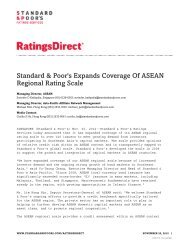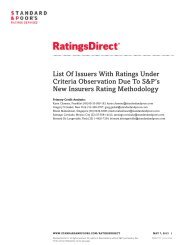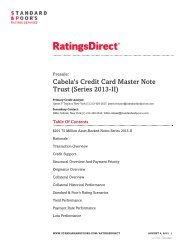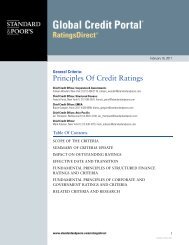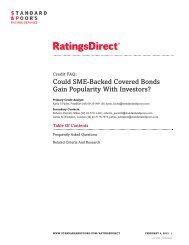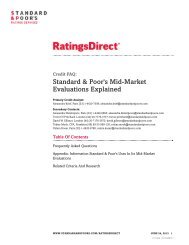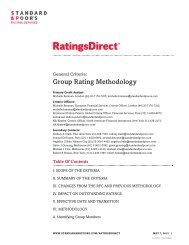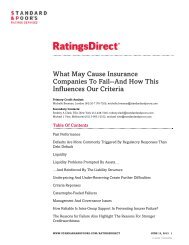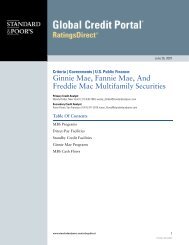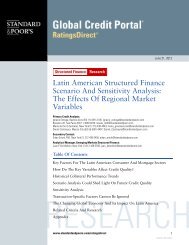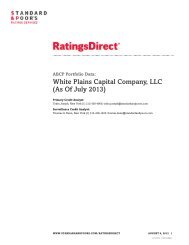Criteria for Rating German Residential Mortgage ... - Standard & Poor's
Criteria for Rating German Residential Mortgage ... - Standard & Poor's
Criteria for Rating German Residential Mortgage ... - Standard & Poor's
You also want an ePaper? Increase the reach of your titles
YUMPU automatically turns print PDFs into web optimized ePapers that Google loves.
<strong>Criteria</strong> | Structured Finance | RMBS:<br />
<strong>Criteria</strong> <strong>for</strong> <strong>Rating</strong> <strong>German</strong><br />
<strong>Residential</strong> <strong>Mortgage</strong>-Backed<br />
Securities<br />
Primary Credit Analysts:<br />
Torsten Althaus, Frankfurt (49) 69-33-999-300; torsten_althaus@standardandpoors.com<br />
Tilmann Kuhfuss, Frankfurt (49) 69-138709-7372<br />
Andre Vollmann, London (44) 20-7826-3855<br />
Karen Naylor, London (44) 20-7826-3533<br />
Victoria Johnstone, London (44) 20-7826-3864<br />
Stephen McCabe, London (44) 20-826-3594<br />
Table Of Contents<br />
Traditional True Sale Structures<br />
Synthetic Structures<br />
The General <strong>Rating</strong> Process<br />
Credit Analysis<br />
Foreclosure Frequency Assumptions<br />
Loss Severity Assumptions<br />
Cash Flow Analysis <strong>for</strong> Funded Synthetic Transactions<br />
Cash Flow Analysis <strong>for</strong> True Sale Transactions<br />
Substitution of Assets<br />
Documentation Aspects of Synthetic RMBS Transactions<br />
Surveillance<br />
August 31, 2001<br />
www.standardandpoors.com/ratingsdirect 1<br />
867630 | 300323561
<strong>Criteria</strong> | Structured Finance | RMBS:<br />
<strong>Criteria</strong> <strong>for</strong> <strong>Rating</strong> <strong>German</strong> <strong>Residential</strong><br />
<strong>Mortgage</strong>-Backed Securities<br />
(Editor's Note: This criteria article originally was published on Aug. 31, 2001. We're republishing this article<br />
following our periodic review completed on March 31, 2011.<br />
These criteria have been updated and clarified by "Methodology And Assumptions: Update To The <strong>Criteria</strong> For<br />
<strong>Rating</strong> <strong>German</strong> <strong>Residential</strong> <strong>Mortgage</strong>-Backed Securities," published on Jan. 6, 2009. Also, part of these criteria have<br />
been superseded by "Cash Flow <strong>Criteria</strong> <strong>for</strong> European RMBS Transactions," published on Nov. 20, 2003, and<br />
"Methodology And Assumptions: Update To The Cash Flow <strong>Criteria</strong> For European RMBS Transactions,"<br />
published on Jan. 6, 2009.)<br />
This article details <strong>Standard</strong> & <strong>Poor's</strong> rating approach to <strong>German</strong> residential mortgage-backed securities (RMBS).<br />
This approach is based on a detailed analysis of <strong>German</strong> mortgage originators' underwriting and servicing<br />
procedures and the per<strong>for</strong>mance of residential mortgages in the <strong>German</strong> market, and on the surveillance of rated<br />
<strong>German</strong> RMBS transactions since 1998.<br />
<strong>German</strong> mortgage transactions rated by <strong>Standard</strong> & <strong>Poor's</strong> to date have included mortgage assets originated by the<br />
following banks:<br />
• Landesbanks;<br />
• Commercial banks;<br />
• Private banks;<br />
• <strong>Mortgage</strong> banks;<br />
• Cooperative banks; and<br />
• Savings banks.<br />
For the purposes of this article, residential mortgage loans refer to loans taken out by individuals, or in certain<br />
circumstances, companies, to finance the purchase of residential properties located in <strong>German</strong>y. Typically, <strong>German</strong><br />
lenders look to the use of the property, rather than the status of the borrower, in determining whether a loan is<br />
classified as residential.<br />
<strong>German</strong> RMBS transactions to date have employed both "true sale" and "synthetic" structures, outlined below and<br />
in table 1. This article addresses both types of transactions, and highlights the differences in the approach where<br />
necessary. A comparison with the <strong>German</strong> Hypotheken Pfandbriefe is also included in table 1. This article does not<br />
outline <strong>Standard</strong> & <strong>Poor's</strong> approach to rating Hypotheken Pfandbriefe (see "<strong>Criteria</strong> <strong>for</strong> <strong>Rating</strong> <strong>German</strong><br />
Pfandbriefe", published on <strong>Rating</strong>sDirect on July 7, 1997 <strong>for</strong> further details of this approach). Hypotheken<br />
Pfandbriefe has been included <strong>for</strong> comparison, as it bears certain similarities to RMBS, and is an important<br />
instrument <strong>for</strong> funding mortgage lending in the <strong>German</strong> market.<br />
<strong>Standard</strong> & Poors | <strong>Rating</strong>sDirect on the Global Credit Portal | August 31, 2001 2<br />
867630 | 300323561
Traditional True Sale Structures<br />
Few <strong>German</strong> RMBS transactions to date are structured as traditional true sale transactions. This involves the sale of<br />
a pool of residential mortgage loans to a bankruptcy-remote special-purpose entity (SPE), which then issues a<br />
number of tranches of rated notes. The key drivers <strong>for</strong> these types of structures are fundraising, balance-sheet<br />
management, and risk management.<br />
Synthetic Structures<br />
Synthetic structures <strong>for</strong> <strong>German</strong> RMBS transactions can be divided into unfunded, partially funded, or fully funded<br />
structures. The key driver <strong>for</strong> this type of structure is capital and risk relief.<br />
Unfunded Structures<br />
Unfunded structures normally take the <strong>for</strong>m of credit default swaps or guarantees. A number of these have been<br />
executed in the <strong>German</strong> market. In this type of structure, the mortgage lender enters into a swap with a<br />
counterparty, typically an OECD bank. This counterparty makes payments to the lender to the extent certain losses<br />
occur on a defined pool of mortgage loans, commonly known as the reference pool.<br />
Partially Funded Structures<br />
As the name suggests, these structures combine an unfunded element, in the <strong>for</strong>m of a credit default swap, with a<br />
funded element, in the <strong>for</strong>m of notes. These notes are issued either by the bank directly, or via an SPE. In both cases,<br />
the notes are backed by appropriately rated collateral or are guaranteed by an appropriately rated counterparty.<br />
Fully Funded Structures<br />
These structures are fully funded, with the notes issued either by the bank directly, or via an SPE. In both cases, the<br />
notes are backed by appropriately rated collateral or are guaranteed by an appropriately rated counterparty.<br />
Table 1<br />
Basic Features of True Sale and Synthetic RMBS vs. Pfandbriefe Transactions<br />
True sale Synthetic<br />
Assets Assets transferred to an SPE Defined pool of reference assets and<br />
a defined notion of losses<br />
Nature of the<br />
assets<br />
RMBS Hypotheken Pfandbriefe<br />
Assets within a cover register<br />
(Deckungsstock)<br />
<strong>Residential</strong> mortgage loans <strong>Residential</strong> mortgage loans Principally residential and commercial<br />
mortgage loans up to 60% lendable value<br />
(Beleihungswert), as defined by the<br />
<strong>Mortgage</strong> Banking Act (Hypothekenbank<br />
Gesetz) and associated rulings<br />
Issuer SPE SPE or a sufficiently rated bank or<br />
any bank with certain collateral<br />
arrangements<br />
Funding Fully funded to match the pool of assets Unfunded, partially funded, or fully<br />
funded based on the obligation of the<br />
rated bank or collateral<br />
arrangements<br />
Balance-sheet<br />
treatment<br />
Principal and<br />
interest payments<br />
<strong>Criteria</strong> Structured Finance RMBS: <strong>Criteria</strong> <strong>for</strong> <strong>Rating</strong> <strong>German</strong> <strong>Residential</strong> <strong>Mortgage</strong>-Backed Securities<br />
Generally designed <strong>for</strong> off-balance-sheet<br />
treatment<br />
Generally designed <strong>for</strong><br />
off-balance-sheet treatment<br />
From the pool of segregated assets From the issuing bank or the<br />
collateral securing the funded<br />
elements<br />
<strong>Mortgage</strong> bank or Landesbank<br />
Fully funded and supported by assets in the<br />
cover register<br />
On-balance-sheet design<br />
Assets of the cover register<br />
www.standardandpoors.com/ratingsdirect 3<br />
867630 | 300323561
Table 1<br />
Basic Features of True Sale and Synthetic RMBS vs. Pfandbriefe Transactions (cont.)<br />
Cash flow analysis Detailed cash flow analysis to ensure the<br />
payments from pool of assets are sufficient<br />
to maintain payments of interest and<br />
principal on the rated debt in a recessionary<br />
environment<br />
Maturity of the<br />
transaction<br />
<strong>Criteria</strong> Structured Finance RMBS: <strong>Criteria</strong> <strong>for</strong> <strong>Rating</strong> <strong>German</strong> <strong>Residential</strong> <strong>Mortgage</strong>-Backed Securities<br />
Dependent on the maturity of the<br />
underlying assets<br />
The General <strong>Rating</strong> Process<br />
Rated collateral usually tailored to<br />
provide cash flows as required.<br />
Interest subparticipation might<br />
require separate cash flow modeling<br />
Potentially part of the transaction<br />
definitions<br />
Detailed cash flow analysis addressing the<br />
dynamic nature of the asset pool<br />
Usually shorter than the underlying assets,<br />
but still dependent on the asset<br />
characteristics<br />
<strong>Standard</strong> & <strong>Poor's</strong> assesses the interaction of structural, legal, and credit quality features in a transaction, and tests<br />
the robustness of these qualities using various assumptions appropriate <strong>for</strong> the rating sought. The conservatism of<br />
the assumptions reflects the level of the rating. In most cases, the rating process includes the following steps:<br />
• An initial meeting is held to discuss the asset characteristics, structure, data requirements, and the time schedule.<br />
With respect to data requirements, <strong>Standard</strong> & <strong>Poor's</strong> asks the originators to supply specific in<strong>for</strong>mation on each<br />
loan in a standardized data template (available on request). The data requested includes items such as loan<br />
balance, property value, etc.<br />
• A one-day visit (corporate overview) is conducted to review the underwriting, servicing, and collection policies<br />
and procedures of the originator (and a servicer if a different entity is employed) of the mortgage loans. A sample<br />
agenda can be found in Appendix 1. Typically, managers (Abteilungsleiter) give presentations on the topics<br />
outlined in the agenda. These topics are crucial to the rating analysis of the mortgage loans to be securitized.<br />
<strong>Standard</strong> & <strong>Poor's</strong> will endeavor to allocate native <strong>German</strong>-speaking primary analysts to <strong>German</strong> transactions.<br />
There<strong>for</strong>e, these presentations can be conducted in <strong>German</strong>.<br />
• The credit quality of the underlying loan is determined, thereby yielding the credit enhancement levels be<strong>for</strong>e any<br />
cash flow analysis. This risk analysis takes into account the results of the servicer review and the credit analysis of<br />
the underlying mortgage loan portfolio (see Foreclosure Frequency Assumptions below). In true sale transactions<br />
and some funded synthetic transactions, final credit enhancement levels are determined after a cash flow analysis<br />
(see Loss Severity Assumptions).<br />
• There is a review of and comments are made on the draft transaction documents and legal opinions. Arranging<br />
banks typically print and distribute the preliminary offering circular at this stage and <strong>Standard</strong> & <strong>Poor's</strong> typically<br />
issues a presale report and assigns preliminary ratings to the transaction. Shortly be<strong>for</strong>e the close of the<br />
transaction a final credit committee will examine whether the prerequisites <strong>for</strong> a final rating are fulfilled, and<br />
whether any outstanding issues have been satisfactorily resolved.<br />
• Following the release of the final rating letter, the transaction will be transferred to the surveillance department.<br />
This department is responsible <strong>for</strong> the ongoing monitoring of the transaction.<br />
Credit Analysis<br />
The credit quality of <strong>German</strong> mortgage pools is assessed by estimating the credit risk associated with each loan in<br />
the pool. The aggregate of this risk is then calculated to assess the overall credit quality of the pool. The credit risk<br />
associated with each loan in the pool is quantified by estimating each loan's probability of default leading to<br />
<strong>for</strong>eclosure and its loss severity (the loss that would be realized as a result of <strong>for</strong>eclosure).<br />
<strong>Standard</strong> & Poors | <strong>Rating</strong>sDirect on the Global Credit Portal | August 31, 2001 4<br />
867630 | 300323561
The potential loss associated with a loan can there<strong>for</strong>e be calculated by multiplying the <strong>for</strong>eclosure frequency with<br />
the loss severity. In order to quantify the potential losses associated with the entire pool, each loan's <strong>for</strong>eclosure<br />
frequency and loss severity is weighted by its percentage of the total pool balance. A weighted-average <strong>for</strong>eclosure<br />
frequency (WAFF) and a weighted-average loss severity (WALS) are then calculated at each rating level. The product<br />
of these two variables estimates the required loss protection, in the absence of additional mitigating factors (e.g.,<br />
excess spread, whether in cash or synthetic) in the transaction.<br />
<strong>Standard</strong> & <strong>Poor's</strong> assumes that as the economic environment declines, the credit risk associated with a particular<br />
pool will increase; that is, more borrowers will default on their loans, and the loss realized as the result of<br />
<strong>for</strong>eclosure will be more extreme. <strong>Standard</strong> & <strong>Poor's</strong>, there<strong>for</strong>e, requires higher loss protection or credit cover <strong>for</strong><br />
the higher rated notes in a mortgage transaction.<br />
The details of <strong>Standard</strong> & <strong>Poor's</strong> assumptions in the calculation of the <strong>for</strong>eclosure frequency and loss severity<br />
measures <strong>for</strong> a <strong>German</strong> mortgage pool are given below.<br />
Foreclosure Frequency Assumptions<br />
Base Foreclosure Frequency<br />
A base <strong>for</strong>eclosure frequency is assumed at each rating level (see table 2). The base <strong>for</strong>eclosure frequency is the<br />
probability of <strong>for</strong>eclosure <strong>for</strong> each loan under each rating scenario. The higher base <strong>for</strong>eclosure frequencies at the<br />
higher rating levels capture the increase in <strong>for</strong>eclosure risk in more stressful economic conditions.<br />
Table 2<br />
Base Foreclosure Frequency Assumptions<br />
<strong>Rating</strong> Base <strong>for</strong>eclosure frequency (%)<br />
AAA 12<br />
AA 8<br />
A 6<br />
BBB 4<br />
It is assumed that a loan will have an increased (or sometimes decreased) <strong>for</strong>eclosure risk compared with the base,<br />
depending on its unique underwriting characteristics. There<strong>for</strong>e, the base <strong>for</strong>eclosure frequency is modified <strong>for</strong> each<br />
loan to address any increase or decrease in risk due to these characteristics. The characteristics that lead to base<br />
<strong>for</strong>eclosure modifications are given in table 3, and discussed in detail in the text thereafter. Loans without any of the<br />
characteristics that attract changes to the <strong>for</strong>eclosure frequency are considered to be benchmark.<br />
There is a recognized need <strong>for</strong> market participants to construct models that replicate these base <strong>for</strong>eclosure<br />
frequency modifications. Table 3 there<strong>for</strong>e outlines the loan characteristics that are considered to have an effect on<br />
<strong>for</strong>eclosure frequency, and provides the associated adjustments that <strong>Standard</strong> & <strong>Poor's</strong> typically advise. It is strongly<br />
emphasized that these are guidelines only, and <strong>for</strong>eclosure adjustments will be increased or decreased after an<br />
analysis of originator-specific underwriting and servicing characteristics, and/or per<strong>for</strong>mance data. In addition,<br />
<strong>Standard</strong> & <strong>Poor's</strong> will continue to monitor and assess <strong>German</strong> mortgage credit risk, and will refine and add criteria<br />
accordingly.<br />
<strong>Criteria</strong> Structured Finance RMBS: <strong>Criteria</strong> <strong>for</strong> <strong>Rating</strong> <strong>German</strong> <strong>Residential</strong> <strong>Mortgage</strong>-Backed Securities<br />
www.standardandpoors.com/ratingsdirect 5<br />
867630 | 300323561
Table 3<br />
<strong>Criteria</strong> Structured Finance RMBS: <strong>Criteria</strong> <strong>for</strong> <strong>Rating</strong> <strong>German</strong> <strong>Residential</strong> <strong>Mortgage</strong>-Backed Securities<br />
Characteristics Affecting Base Foreclosure Frequency and Related Adjustment Guidelines<br />
Description of characteristic Foreclosure frequency adjustment guidelines<br />
Loan-to-value (LTV) < 55% Base multiplied by 0.8<br />
LTV 55% to 80% Base multiplied by 1.0 (no change)<br />
LTV > 80% Base multiplied by 1.1 to 3.0 according to a continuous function.<br />
Indicative multiples at discrete LTV levels are given as follows:<br />
85% LTV = base multiplied by 1.2<br />
90% LTV = base multiplied by 1.6<br />
95% LTV = base multiplied by 2.4<br />
100% LTV = base multiplied by 3.0<br />
Interest-only loans (endfaellige Darlehen) without satisfactory<br />
additional collateral (term < 20 years)<br />
Base multiplied by 1.67<br />
Letting loans (fremdvermietete Objekte) Base multiplied by 1.5 to 1.8 and then added to base (e.g., <strong>for</strong> a base of 12%: base<br />
multiplied by 1.67 = 20%; base plus 20% = 32%<br />
Loan size > €400,000 or equivalent Increases by 1% to 20% of base (increases as loan size increases and caps when<br />
loan size reaches €1,000,000)<br />
Unacceptable geographic concentration Case-by-case consideration<br />
Af<strong>for</strong>dability not adequately assessed Case-by-case consideration<br />
Completion date >18 months (with no arrears) Subtract 10% to 25% of base (increases as seasoning increases and caps when<br />
seasoning reaches about 60 months)<br />
Arrears Case-by-case consideration, based on arrears management and per<strong>for</strong>mance data<br />
Loan-to-Value (LTV)<br />
LTV is defined as the ratio of aggregate mortgage debt divided by the value of the property. This ratio has<br />
historically been a key <strong>for</strong>eclosure predictor, with low LTV ratios associated with lesser probabilities of loan default.<br />
A low LTV ratio indicates that a borrower has a high equity investment in a property, but can also indicate some<br />
prior financial management.<br />
<strong>Standard</strong> & <strong>Poor's</strong> ability to rely on LTV ratios is crucial, given that the LTV ratio is important in the estimation of<br />
<strong>for</strong>eclosure frequency (and loss severity, see below). In general, securitized loans in <strong>German</strong>y have benefited from<br />
full property valuations. <strong>German</strong> mortgage lending banks typically have in-house valuation experts, with extensive<br />
experience in the building and construction industry.<br />
<strong>German</strong> banks normally use a material value method (Sachwertverfahren) or a return value method<br />
(Ertragswertverfahren) to determine the value of a property. The resulting market valuation is then deducted by a<br />
certain percentage to give a "lendable" value or Beleihungswert. Lenders use this reduction as potential coverage in<br />
a <strong>for</strong>ced sale situation. Typically, the less liquid the property is considered to be, the higher the deducted percentage<br />
(or haircut) is from the property value. This approach stems from <strong>Mortgage</strong> Banking Act requirements <strong>for</strong> those<br />
banks regulated by this act, but has also been adopted by nonmortgage banks.<br />
In order to give benefit to this conservative valuation haircut, <strong>Standard</strong> & <strong>Poor's</strong> adjusts the lendable values in its<br />
calculation of LTV ratios. Subsequent references to LTV in this article refer to this adjusted LTV. The degree of<br />
uplift to the valuation depends on the transaction structure. In synthetic structures, where a minimum level of<br />
haircut is stated in the eligibility criteria, and where all losses are audited prior to being allocated, <strong>Standard</strong> &<br />
<strong>Poor's</strong> will typically re-engineer the valuation, giving full benefit to the haircut. The timing and comprehensiveness<br />
of the audit will affect this analysis. In the case of true sale transactions, partial benefit is given, resulting in a<br />
valuation that is below market value but in excess of the Beleihungswert.<br />
<strong>Standard</strong> & Poors | <strong>Rating</strong>sDirect on the Global Credit Portal | August 31, 2001 6<br />
867630 | 300323561
Note that in the case of multiple loans secured on one property, the aggregate of this mortgage debt is used to<br />
calculate a single LTV per property.<br />
Loan Repayment Type<br />
Most <strong>German</strong> residential mortgage loans have fixed interest rates and fixed repayment characteristics <strong>for</strong> a period of<br />
time. The length of this fixing period varies from one to 15 years, but is most commonly set at five to 10 years.<br />
Upon maturity of the fixing period, the lending bank is obliged to provide a new offer <strong>for</strong> the next fixing period.<br />
The offer typically relates to a new interest rate, but some lenders allow the principal amortization features to<br />
change as well. <strong>Mortgage</strong> payments are usually direct debited monthly, but quarterly, semiannual, and annual<br />
payments can also be arranged.<br />
Borrowers repay their loan using either a full repayment or an interest-only scheme (endfaelliges Darlehen). With a<br />
full repayment loan, the principal amortizes over the life of the loan; that is, the borrower repays principal and pays<br />
interest at each mortgage payment date. <strong>Standard</strong> & <strong>Poor's</strong> does not consider repayment loans to have any increased<br />
or decreased risk of <strong>for</strong>eclosure, but these loan types can affect the structural analysis (see Extension Risk below).<br />
With an interest-only loan, the borrower makes monthly interest payments, with the total principal due at final<br />
maturity. <strong>German</strong> borrowers typically accrue this principal payment elsewhere (e.g., in a life insurance investment<br />
vehicle, Kapitallebensversicherung, or in a building society savings plan, Bausparvertrag). These schemes are<br />
normally assigned to the lender and used to redeem the loan at maturity.<br />
<strong>Standard</strong> & <strong>Poor's</strong> will discuss with the originator to what degree any additional security has been taken <strong>for</strong><br />
interest-only loans, and will examine the potential mismatch between the collateral arrangements and the mortgage<br />
loan amount due at maturity to assess any refinancing risk. After these assessments, interest-only loans with original<br />
terms of less than 20 years may be considered to carry greater credit risk.<br />
Letting Loans<br />
In general, there is relatively low home ownership in <strong>German</strong>y compared with other European countries.<br />
Letting-loan properties are exposed to different risks than owner-occupied properties. Such risks include the<br />
borrower's level of reliance on the rental receipts to meet mortgage payments, and the borrower's prior experience<br />
in managing rental properties.<br />
The <strong>German</strong> environment <strong>for</strong> letting properties exposes the borrower to a number of additional risks. Primarily,<br />
there are tax incentives associated with rental properties, so high degrees of leverage are often used to maximize<br />
these benefits. The tax benefits can also result in inflated prices <strong>for</strong> rental properties.<br />
Secondly, there are strong legal tenant protections. These protections fix the maximum increase in rent amount,<br />
allow <strong>for</strong> increases in the tenant resignation period over time, and restrict the landlord's ability to terminate the<br />
renting contract.<br />
Lastly, the yield associated with rental properties is generally low. Without incorporating the tax benefit,<br />
occasionally the yield is lower than the interest owed on the mortgage loan. Thus, any delays in the implementation<br />
of the tax deductions after the purchase of a letting property can place financial stress on a highly leveraged<br />
borrower.<br />
<strong>Criteria</strong> Structured Finance RMBS: <strong>Criteria</strong> <strong>for</strong> <strong>Rating</strong> <strong>German</strong> <strong>Residential</strong> <strong>Mortgage</strong>-Backed Securities<br />
In order to account <strong>for</strong> these additional risks, the <strong>for</strong>eclosure frequencies assigned to <strong>German</strong> rental properties are<br />
generally much higher than owner-occupied properties.<br />
www.standardandpoors.com/ratingsdirect 7<br />
867630 | 300323561
<strong>Criteria</strong> Structured Finance RMBS: <strong>Criteria</strong> <strong>for</strong> <strong>Rating</strong> <strong>German</strong> <strong>Residential</strong> <strong>Mortgage</strong>-Backed Securities<br />
Note that <strong>Standard</strong> & <strong>Poor's</strong> considers family homes with an attached rental flat to be owner-occupied and as such<br />
do not attract the additional <strong>for</strong>eclosure risk of a letting-only property.<br />
Loan Size<br />
Large loans are considered to have more inherent risk than smaller loans owing to the increased sensitivity of these<br />
borrowers to changes in their financial situation in times of recession. Jumbo loans are defined as loans with a<br />
balance of more than €400,000. This limit will be adjusted on an ongoing basis to reflect regional price differences.<br />
Geographic Concentration<br />
If a pool is not suitably diversified by region, a local economic downturn can adversely affect the losses in the<br />
mortgage pool. <strong>Standard</strong> & <strong>Poor's</strong> generally considers the effect of regional concentrations on <strong>for</strong>eclosure<br />
frequencies on a case-by-case basis. In this analysis, the proportion of the pool in each geographic area is compared<br />
with the population distribution of <strong>German</strong>y as a whole. If they correspond approximately, typically no additional<br />
<strong>for</strong>eclosure risk will be assumed.<br />
Af<strong>for</strong>dability<br />
<strong>Standard</strong> & <strong>Poor's</strong> will assess how the servicer calculates the borrower's long-term income available <strong>for</strong> loan<br />
repayment (frei verfügbares Einkommen, Kapitaldienstfähigkeit), and the frequency with which it updates averaged<br />
expense predictions based on borrower characteristics (Ausgabenpauschalen). <strong>Standard</strong> & <strong>Poor's</strong> may conclude that<br />
a borrower's financial ability to repay the loan may be compromised if these procedures are not deemed to be<br />
adequate, and will increase the <strong>for</strong>eclosure frequency accordingly.<br />
Seasoning<br />
Historical data indicates that the most likely period in which a borrower will default is the first five years following<br />
completion. A mortgage that has been outstanding <strong>for</strong> a significant period of time (and is not currently in arrears) is,<br />
there<strong>for</strong>e, considered to have a lower likelihood of <strong>for</strong>eclosure.<br />
Arrears<br />
Loans in arrears clearly have a greater propensity to go into <strong>for</strong>eclosure given their status. <strong>Standard</strong> & <strong>Poor's</strong><br />
recognizes that collection ef<strong>for</strong>ts made by the lender will reduce the probability of <strong>for</strong>eclosure <strong>for</strong> loans in arrears.<br />
<strong>Standard</strong> & <strong>Poor's</strong> will also analyze the types of per<strong>for</strong>ming arrangements and arrears management procedures<br />
utilized by an originator, and consider originator-specific per<strong>for</strong>mance data and roll rates when sizing the<br />
<strong>for</strong>eclosure risks associated with loans in arrears.<br />
Second-Charge <strong>Mortgage</strong>s<br />
Unlike in some other European jurisdictions (e.g., the U.K.), in <strong>German</strong>y <strong>Standard</strong> & <strong>Poor's</strong> assumes no increase in<br />
the assumed <strong>for</strong>eclosure frequency <strong>for</strong> second mortgages. Multiple loans secured off one property is the norm in<br />
<strong>German</strong>y and generally reflects market lending practices rather than additional borrowing to finance, <strong>for</strong> example,<br />
home improvements.<br />
Loss Severity Assumptions<br />
Loss severity is the estimated loss that will be realized on a defaulted loan. A loss is realized on a loan if the sale of<br />
the repossessed property does not cover the costs associated with en<strong>for</strong>cing the mortgage, the accrued interest on the<br />
loan during the <strong>for</strong>eclosure period, and the remaining loan balance. The loss severity is calculated by dividing this<br />
realized loss by the loan balance, expressed as a percentage.<br />
<strong>Standard</strong> & Poors | <strong>Rating</strong>sDirect on the Global Credit Portal | August 31, 2001 8<br />
867630 | 300323561
Market Value Decline<br />
The rating analysis assumes that the sale proceeds received from a property are less than the original valuation of the<br />
property, owing to a recessionary market value decline. <strong>Standard</strong> & <strong>Poor's</strong> market value decline assumptions <strong>for</strong><br />
<strong>German</strong> residential properties are shown in table 4. These market value declines are both rating and loan dependent.<br />
The tax incentives associated with rental properties can result in overly inflated prices <strong>for</strong> these types of properties.<br />
<strong>Standard</strong> & <strong>Poor's</strong> there<strong>for</strong>e assumes that a rental property will show a greater market value decline than an<br />
owner-occupied property.<br />
Table 4<br />
Market Value Decline Assumptions<br />
<strong>Rating</strong> <strong>Standard</strong> market value declines (%) Letting loans market value declines (%)<br />
AAA 35 45<br />
AA 30 40<br />
A 26 36<br />
BBB 22 32<br />
Jumbo Valuations<br />
Properties with high valuations are assumed to experience higher loss severities owing to the smaller and less liquid<br />
market <strong>for</strong> these types of properties. A property with a valuation greater than €500,000 attracts a 1% to 20%<br />
increase in loss severity, which increases as the property valuation increases and caps at about €1,000,000. As with<br />
jumbo loan limits, this limit will be adjusted on a continuing basis to reflect regional price differences.<br />
Foreclosure Costs, Foreclosure Period, and Accrued Interest<br />
The fixed costs associated with <strong>for</strong>eclosure are assumed to be, on average, 6% of the loan balance <strong>for</strong> each defaulted<br />
loan. This figure includes all costs and fees resulting from the pursuit of arrears, litigation, administration,<br />
maintenance, and sale of the property. Where loss protection needs to be sized <strong>for</strong> the interest accrued during the<br />
<strong>for</strong>eclosure period (e.g., in some synthetic structures, and in true sale structures without a cash flow simulation), a<br />
24-month <strong>for</strong>eclosure period and a stressed interest rate of 8% to 12% are assumed.<br />
Second Charge <strong>Mortgage</strong>s<br />
<strong>Standard</strong> & <strong>Poor's</strong> loss severity calculations also account <strong>for</strong> prior-ranking mortgages not included in the<br />
securitization. The proceeds from the sale of the property are used to fulfill the prior-ranking obligation (including<br />
the loan balance, costs of <strong>for</strong>eclosure, and interest accrued during the <strong>for</strong>eclosure period) be<strong>for</strong>e they are used to<br />
cover the second charge securitized loan.<br />
Loss Severity Calculation Example<br />
An example of <strong>Standard</strong> & <strong>Poor's</strong> loss severity calculation <strong>for</strong> an individual loan is shown in table 5.<br />
Table 5<br />
<strong>Criteria</strong> Structured Finance RMBS: <strong>Criteria</strong> <strong>for</strong> <strong>Rating</strong> <strong>German</strong> <strong>Residential</strong> <strong>Mortgage</strong>-Backed Securities<br />
'AAA' Loss Severity Calculation <strong>for</strong> a First Ranking Loan, Assuming an LTV of 80%<br />
Original property value 100,000<br />
Loan balance 80,000<br />
Foreclosure proceeds 100,000 minus 'AAA' market value decline of 35% = 65,000<br />
Gross loss 15,000<br />
Realization costs<br />
24 months accrued interest at 12% 19,200<br />
Selling, legal and other costs at 6% 4,800<br />
www.standardandpoors.com/ratingsdirect 9<br />
867630 | 300323561
Table 5<br />
'AAA' Loss Severity Calculation <strong>for</strong> a First Ranking Loan, Assuming an LTV of 80% (cont.)<br />
Total costs and interest 24,000<br />
Net loss<br />
39,000<br />
Loss severity = net loss divided by loan balance 39,000 divided by 80,000 = 48.75%<br />
Large Exposure Risk<br />
Given the relatively low risk nature of <strong>German</strong> mortgages, and the exclusion of certain risks through synthetic<br />
transactions, the credit enhancement levels at the lower rating levels are sometimes sensitive to large exposures. In<br />
order to examine this sensitivity, <strong>Standard</strong> & <strong>Poor's</strong> compares the enhancement levels required when the whole pool<br />
is included in the credit analysis, with those obtained from subpools of the largest exposures. If necessary, <strong>Standard</strong><br />
& <strong>Poor's</strong> will increase the required credit enhancement after this analysis.<br />
Cash Flow Analysis <strong>for</strong> Funded Synthetic Transactions<br />
<strong>Standard</strong> & <strong>Poor's</strong> ratings address the likelihood of full and timely payment of interest and principal in accordance<br />
with the terms of the obligation. This is true <strong>for</strong> both funded synthetic and true sale transactions.<br />
In funded synthetic structures, it is the collateral (such as Pfandbriefe or government bonds) that generates the<br />
interest and principal that is used to pay interest and repay principal on the rated notes. This collateral backs the<br />
obligations of the issuing bank to make principal and interest payments, and allows the issuing bank to obtain<br />
ratings on the notes that are higher than its own. Often, the collateral has the same interest rate and maturities as<br />
the rated notes.<br />
To the extent the bank issuing the notes fails to make a payment, the trustee will liquidate the collateral and pass on<br />
the proceeds to noteholders. If the proceeds from liquidation are insufficient to redeem the notes in full, the trustee<br />
will deliver a proportional amount of the collateral to the noteholders as payment in kind.<br />
If the collateral is not grossed up <strong>for</strong> withholding tax deductions, <strong>Standard</strong> & <strong>Poor's</strong> will request a legal opinion<br />
confirming that there is no current or pending withholding tax payable.<br />
Cash Flow Analysis <strong>for</strong> True Sale Transactions<br />
True sale mortgage securitizations involve the issuance of rated bonds, which are split into tranches of differing<br />
seniority (so-called "senior-subordinated" structures). Seniority may be related to payment of interest, principal, or<br />
both.<br />
Beneath the rated bonds there usually exists a first-loss fund provided by the originator of the assets, often called the<br />
"reserve fund". The reserve fund is used to cover both interest shortfalls and principal losses arising in the<br />
transaction.<br />
<strong>Criteria</strong> Structured Finance RMBS: <strong>Criteria</strong> <strong>for</strong> <strong>Rating</strong> <strong>German</strong> <strong>Residential</strong> <strong>Mortgage</strong>-Backed Securities<br />
The transaction might also incorporate specific structural features designed to minimize the issuer's exposure to<br />
external economic factors (e.g., interest rate hedges). A cash flow model will usually be created to replicate the asset<br />
and liability structure over the life of the transaction.<br />
The transaction cash flows are stressed in order to test both the credit and liquidity support provided by the assets,<br />
<strong>Standard</strong> & Poors | <strong>Rating</strong>sDirect on the Global Credit Portal | August 31, 2001 10<br />
867630 | 300323561
subordinated tranches, cash reserve, and any external sources (such as a liquidity facility). Stresses to the cash flows<br />
are implemented at all relevant rating levels.<br />
Defaults<br />
Defaults are assumed to occur over a three-year recession. The effect of the timing of this recession on the ability of<br />
the assets to repay the liabilities is assessed, and the recession start period will be chosen on the basis of this<br />
assessment.<br />
Although the recession normally starts in the first month of the transaction, the 'AAA' recession is usually delayed<br />
by a further 12 months. As described above, the cumulative level of defaults within a mortgage pool is given by the<br />
WAFF. The WAFF is applied to the principal balance outstanding at the start of the recession. Defaults are assumed<br />
to occur periodically in amounts calculated as a percentage of the WAFF.<br />
The timing of defaults generally follows two paths, referred to here as "fast" and "slow" defaults. These timings are<br />
shown in table 6. In most cases, the fast default curve is applied, unless the transaction is more sensitive to the slow<br />
default curve.<br />
Table 6<br />
<strong>Criteria</strong> Structured Finance RMBS: <strong>Criteria</strong> <strong>for</strong> <strong>Rating</strong> <strong>German</strong> <strong>Residential</strong> <strong>Mortgage</strong>-Backed Securities<br />
Default Bullets <strong>for</strong> Fast and Slow Default Curves<br />
Recession month Fast default (% of WAFF) Slow default (% of WAFF)<br />
1 30 0<br />
6 30 5<br />
12 20 5<br />
18 10 10<br />
24 5 20<br />
30 5 30<br />
36 0 30<br />
Recoveries<br />
<strong>Standard</strong> & <strong>Poor's</strong> assumes that the recovery of proceeds from <strong>for</strong>eclosure and sale of repossessed properties will<br />
occur 24 months following a payment default. The value of recoveries will be equal to the defaulted amount less the<br />
WALS. The WALS used in a cash flow model will usually be based on principal alone, including costs. During the<br />
<strong>for</strong>eclosure period, unpaid interest on defaulted mortgages will accrue in the cash flow model depending on the<br />
current interest rate, which itself is varied according to certain criteria (see below).<br />
Delinquencies<br />
The liquidity stress that results from short-term delinquencies, i.e., those mortgages that cease to pay <strong>for</strong> a period of<br />
time but then recover and become current with respect to both interest and principal, is also modeled. To simulate<br />
the effect of delinquencies, interest receipts equal to one-third of the WAFF are assumed to be delayed.<br />
This assumption applies <strong>for</strong> the first 18 months of the recession, and full recovery of delinquent interest is assumed<br />
to occur after a period of 18 months. Thus, if in month five of the recession the total collateral interest is €1 million<br />
and the WAFF is 30%, €100,000 of interest (one-third of the WAFF) will be delayed until month 29.<br />
Interest and Prepayment Rates<br />
Three different interest rate scenarios—rising, falling, and stable—are modeled using both high and low prepayment<br />
assumptions. This gives rise to six different stress scenarios at each rating level. Interest rates always start from<br />
www.standardandpoors.com/ratingsdirect 11<br />
867630 | 300323561
EURIBOR at the time of modeling. For rising interest rates, EURIBOR rises by 2% per month to a ceiling of 12%,<br />
where it remains <strong>for</strong> the rest of the transaction's life. For falling interest rates, EURIBOR falls by 2% per month to a<br />
floor of 2%, where it remains <strong>for</strong> the rest of the transaction's life. For stable interest rates, EURIBOR is held at the<br />
current level throughout the life of the transaction. In the 'AAA' scenario the interest rate increase will not begin<br />
until month 13.<br />
<strong>Criteria</strong> Structured Finance RMBS: <strong>Criteria</strong> <strong>for</strong> <strong>Rating</strong> <strong>German</strong> <strong>Residential</strong> <strong>Mortgage</strong>-Backed Securities<br />
High and low prepayments are set at 30.0% and 0.5% per annum and applied on a monthly basis to the decreasing<br />
mortgage balance. In 'AAA' scenarios where the recession starts in month 13, the prepayment rate in the first year is<br />
set to an intermediate rate of 15% per annum. <strong>Standard</strong> & <strong>Poor's</strong> reserves the right to increase the high prepayment<br />
assumption in the event that historical prepayment rates are at high levels, or the transaction is particularly sensitive<br />
to high prepayments (e.g., in the case of a transaction that relies heavily on excess spread).<br />
Interest rate and prepayment rate scenarios are revised if there is sufficient evidence to warrant such adjustments.<br />
Reinvestment Rates<br />
Unless the transaction has the benefit of a guaranteed investment contract (GIC) with an appropriately rated entity,<br />
it is assumed that the transaction will suffer from a lower margin on reinvested redemption proceeds and other cash<br />
held in the SPE than the margin received on the underlying assets.<br />
If proceeds are received and reinvested throughout the quarter, and the long-term rating of the GIC provider is<br />
lower than that of the rated notes being subjected to the stress, then the reinvestment rate is assumed to be<br />
EURIBOR less a rating-dependent margin, with a floor of 2%.<br />
The rating-dependent margin is a multiple of the contractual margin. The multiple used <strong>for</strong> this calculation varies<br />
from three at the 'AA' level to five at the 'AAA' level. For example, if the contractual reinvestment rate is EURIBOR<br />
minus 50 basis points (bps), the assumed reinvestment rate would be EURIBOR minus 150 bps <strong>for</strong> the 'AA' level,<br />
and EURIBOR minus 250 bps <strong>for</strong> 'AAA'. If the GIC provider has an 'A-1+' short-term rating (but not a 'AAA'<br />
long-term rating) the actual GIC rate can be relied upon <strong>for</strong> the first year of the transaction in a 'AAA' scenario, but<br />
must revert to the stressed rate thereafter.<br />
Originator Insolvency<br />
<strong>Mortgage</strong> payments from borrowers are typically paid by direct debit into a collection account, transferred to a<br />
transaction account in the name of the issuer, and finally credited to the GIC account. The collection account is<br />
often not in the name of the issuer, as most originators do not want to ask borrowers to change their direct debit<br />
instructions as a result of a securitization.<br />
The degree to which insolvency of the originator will affect the cash flow from the assets depends, there<strong>for</strong>e, on the<br />
collection account characteristics. The amount at risk depends on the timing of payments from borrowers and the<br />
frequency with which these funds are transferred to the transaction account. If all borrowers pay on the same day of<br />
the month, then even with daily sweeping of the collection account, up to one month's cash flow from the assets is<br />
potentially at risk. This risk must be modeled appropriately <strong>for</strong> each transaction, but could result in a loss of one<br />
month's cash flow, depending on the legal analysis.<br />
Expenses<br />
All the issuer's <strong>for</strong>eseeable expenses should be modeled. <strong>Standard</strong> & <strong>Poor's</strong> normally requires a schedule of these<br />
expenses to be provided. In addition to <strong>for</strong>eseeable expenses, the model should contain amounts sized <strong>for</strong> contingent<br />
<strong>Standard</strong> & Poors | <strong>Rating</strong>sDirect on the Global Credit Portal | August 31, 2001 12<br />
867630 | 300323561
expenses. This amount depends on the size of the transaction, and can be modeled either as a separate contingency<br />
reserve or a haircut to the reserve fund, or can be addressed through an appropriate guarantee.<br />
Substitution of Assets<br />
Some transactions allow <strong>for</strong> the substitution of mortgage loans as the original mortgage loans repay. In order to<br />
ensure that the credit quality of the portfolio does not deteriorate, a substitution model has been developed <strong>for</strong> use<br />
by originators. This model should be run <strong>for</strong> each substitution to ensure that the level of credit enhancement remains<br />
sufficient.<br />
<strong>Criteria</strong> Structured Finance RMBS: <strong>Criteria</strong> <strong>for</strong> <strong>Rating</strong> <strong>German</strong> <strong>Residential</strong> <strong>Mortgage</strong>-Backed Securities<br />
Additional requirements include a limitation on how many loans may be substituted in any one quarter (10% of<br />
principal outstanding), a cap on the proportion of delinquencies on the existing pool (cannot exceed 2% of principal<br />
outstanding), and a restriction on the proportion of the first loss tranche used to cover losses (no more than 25%).<br />
Documentation Aspects of Synthetic RMBS Transactions<br />
Given that a high proportion of <strong>German</strong> RMBS transactions are synthetic transactions, a number of important<br />
documentation issues are highlighted below.<br />
Definition of Losses<br />
In synthetic transactions, losses can be divided into principal losses, interest losses, and losses associated with<br />
<strong>for</strong>eclosure costs. It is also possible to differentiate between losses occurring on the balances of the loans to be<br />
securitized, and the same losses occurring on prior-ranking loans that are not included in the securitization.<br />
It is important that the documentation clearly specify which risks are being transferred. The originator sets the<br />
definition of losses arising from the reference pool <strong>for</strong> which it is seeking credit protection. There<strong>for</strong>e, the loss<br />
definitions can differ from one transaction to another. While the definition of losses can be tailored <strong>for</strong> the reference<br />
pool, it is not possible to do this <strong>for</strong> prior-ranking loans that are not in this pool.<br />
Accordingly, <strong>Standard</strong> & <strong>Poor's</strong> needs to know the prior-ranking balances, held with third party banks or the<br />
originator (or both), to be able to calculate losses which will occur on these prior-ranking balances. In addition, the<br />
allocation of recoveries in the synthetic waterfall needs to reflect the degree to which accrued interest and<br />
<strong>for</strong>eclosure costs have been excluded from the loss definition. If these items have been excluded, then they must rank<br />
junior in the waterfall.<br />
Conditions <strong>for</strong> Loss Allocations<br />
The conditions under which losses are allocated are key in synthetic transactions. The trustee's plausibility check of<br />
transaction reports, its audits of loans that lead to losses (eligibility criteria, credit and collections procedures, and<br />
servicing practices, as determined in the offering circular), and the timing of loss allocations are regarded as crucial.<br />
In addition, the scope of the audits with respect to the eligibility criteria, credit collection policies, and other<br />
servicing requirements is considered to have a crucial effect on the transaction.<br />
Extension Risk<br />
<strong>German</strong> repayment mortgage loans allow certain terms of the mortgage, namely the interest rate and the<br />
amortization rate, to be renegotiated at the refix (renewal) date. If the borrower renegotiates amortization rates at<br />
the refix date, this can extend the final maturity of the mortgage loan.<br />
www.standardandpoors.com/ratingsdirect 13<br />
867630 | 300323561
In order to ensure that that all principal from the underlying assets is received prior to the maturity of the rated<br />
notes, one of the following mechanisms has been employed to date:<br />
• The servicer agrees to not allow a borrower to reduce the amortization rate.<br />
• The transaction is structured with a final maturity date after the expected maturity of the underlying mortgage<br />
loans.<br />
• In the case of a synthetic transaction, a credit event with regards to the loans in the reference pool should be<br />
allowed to occur only up until the expected final maturity.<br />
Surveillance<br />
<strong>Criteria</strong> Structured Finance RMBS: <strong>Criteria</strong> <strong>for</strong> <strong>Rating</strong> <strong>German</strong> <strong>Residential</strong> <strong>Mortgage</strong>-Backed Securities<br />
Continuous surveillance is carried out throughout the life of the transaction to ensure that it is per<strong>for</strong>ming in<br />
accordance with the initial rating assumptions, and to monitor changes in the underlying per<strong>for</strong>mance of the assets.<br />
The purpose of surveillance is to ensure that the ratings assigned continue to reflect the structure and per<strong>for</strong>mance of<br />
the transaction, and the likelihood that interest and principal will continue to be paid on time and in full in<br />
circumstances reflective of the assigned rating.<br />
If the per<strong>for</strong>mance of the underlying assets or of the transaction itself deteriorates or improves to the extent that the<br />
rating originally assigned is no longer a true reflection of the risk of nonpayment, <strong>Standard</strong> & <strong>Poor's</strong> reserves the<br />
right to change its rating accordingly.<br />
The rating of a transaction may also be changed to reflect revisions in the rating of a supporting party to the<br />
transaction or as a result of regulatory or other issues that have an effect on the transaction.<br />
It is a requirement of a <strong>Standard</strong> & <strong>Poor's</strong> rating that per<strong>for</strong>mance data is received on a regular basis throughout the<br />
transaction's life. This is typically provided monthly or quarterly, and is provided by the issuer, or servicer on its<br />
behalf, with all relevant in<strong>for</strong>mation on the assets and the liabilities needed to maintain comprehensive surveillance.<br />
There is a standard set of surveillance data requirements <strong>for</strong> all <strong>German</strong> RMBS transactions. These are discussed<br />
with the originator at the corporate overview, and any variations to reflect, <strong>for</strong> example, particular products, are<br />
incorporated at this stage. A copy of these surveillance data requirements is available on request.<br />
<strong>Standard</strong> & Poors | <strong>Rating</strong>sDirect on the Global Credit Portal | August 31, 2001 14<br />
867630 | 300323561
Copyright © 2012 by <strong>Standard</strong> & <strong>Poor's</strong> Financial Services LLC. All rights reserved.<br />
No content (including ratings, credit-related analyses and data, model, software or other application or output therefrom) or any part thereof (Content) may be modified,<br />
reverse engineered, reproduced or distributed in any <strong>for</strong>m by any means, or stored in a database or retrieval system, without the prior written permission of <strong>Standard</strong> & <strong>Poor's</strong><br />
Financial Services LLC or its affiliates (collectively, S&P). The Content shall not be used <strong>for</strong> any unlawful or unauthorized purposes. S&P and any third-party providers, as well<br />
as their directors, officers, shareholders, employees or agents (collectively S&P Parties) do not guarantee the accuracy, completeness, timeliness or availability of the<br />
Content. S&P Parties are not responsible <strong>for</strong> any errors or omissions (negligent or otherwise), regardless of the cause, <strong>for</strong> the results obtained from the use of the Content, or<br />
<strong>for</strong> the security or maintenance of any data input by the user. The Content is provided on an "as is" basis. S&P PARTIES DISCLAIM ANY AND ALL EXPRESS OR IMPLIED<br />
WARRANTIES, INCLUDING, BUT NOT LIMITED TO, ANY WARRANTIES OF MERCHANTABILITY OR FITNESS FOR A PARTICULAR PURPOSE OR USE, FREEDOM FROM BUGS,<br />
SOFTWARE ERRORS OR DEFECTS, THAT THE CONTENT'S FUNCTIONING WILL BE UNINTERRUPTED, OR THAT THE CONTENT WILL OPERATE WITH ANY SOFTWARE OR<br />
HARDWARE CONFIGURATION. In no event shall S&P Parties be liable to any party <strong>for</strong> any direct, indirect, incidental, exemplary, compensatory, punitive, special or<br />
consequential damages, costs, expenses, legal fees, or losses (including, without limitation, lost income or lost profits and opportunity costs or losses caused by negligence)<br />
in connection with any use of the Content even if advised of the possibility of such damages.<br />
Credit-related and other analyses, including ratings, and statements in the Content are statements of opinion as of the date they are expressed and not statements of fact.<br />
S&P's opinions, analyses, and rating acknowledgment decisions (described below) are not recommendations to purchase, hold, or sell any securities or to make any<br />
investment decisions, and do not address the suitability of any security. S&P assumes no obligation to update the Content following publication in any <strong>for</strong>m or <strong>for</strong>mat. The<br />
Content should not be relied on and is not a substitute <strong>for</strong> the skill, judgment and experience of the user, its management, employees, advisors and/or clients when making<br />
investment and other business decisions. S&P does not act as a fiduciary or an investment advisor except where registered as such. While S&P has obtained in<strong>for</strong>mation from<br />
sources it believes to be reliable, S&P does not per<strong>for</strong>m an audit and undertakes no duty of due diligence or independent verification of any in<strong>for</strong>mation it receives.<br />
To the extent that regulatory authorities allow a rating agency to acknowledge in one jurisdiction a rating issued in another jurisdiction <strong>for</strong> certain regulatory purposes, S&P<br />
reserves the right to assign, withdraw, or suspend such acknowledgement at any time and in its sole discretion. S&P Parties disclaim any duty whatsoever arising out of the<br />
assignment, withdrawal, or suspension of an acknowledgment as well as any liability <strong>for</strong> any damage alleged to have been suffered on account thereof.<br />
S&P keeps certain activities of its business units separate from each other in order to preserve the independence and objectivity of their respective activities. As a result,<br />
certain business units of S&P may have in<strong>for</strong>mation that is not available to other S&P business units. S&P has established policies and procedures to maintain the<br />
confidentiality of certain nonpublic in<strong>for</strong>mation received in connection with each analytical process.<br />
S&P may receive compensation <strong>for</strong> its ratings and certain analyses, normally from issuers or underwriters of securities or from obligors. S&P reserves the right to disseminate<br />
its opinions and analyses. S&P's public ratings and analyses are made available on its Web sites, www.standardandpoors.com (free of charge), and www.ratingsdirect.com<br />
and www.globalcreditportal.com (subscription), and may be distributed through other means, including via S&P publications and third-party redistributors. Additional<br />
in<strong>for</strong>mation about our ratings fees is available at www.standardandpoors.com/usratingsfees.<br />
www.standardandpoors.com/ratingsdirect 15<br />
867630 | 300323561




